
The Swedish nobility has historically been a legally and/or socially privileged class in Sweden, and part of the so-called frälse. The archaic term for nobility, frälse, also included the clergy, a classification defined by tax exemptions and representation in the diet. Today the nobility does not maintain its former legal privileges although family names, titles and coats of arms are still protected. The Swedish nobility consists of both "introduced" and "unintroduced" nobility, where the latter has not been formally "introduced" at the House of Nobility (Riddarhuset). The House of Nobility still maintains a fee for male members over the age of 18 for upkeep on pertinent buildings in Stockholm.
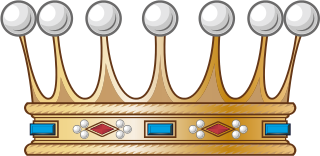
Freiherr, Freifrau and Freiin are designations used as titles of nobility in the German-speaking areas of the Holy Roman Empire and in its various successor states, including Austria, Prussia, Bavaria, Liechtenstein, Luxembourg, etc. Traditionally, it denotes the titled rank within the nobility above Ritter (knight) and Edler and below Graf. The title superseded the earlier medieval form, Edelherr.

The Russian nobility or dvoryanstvo arose in the Middle Ages. In 1914, it consisted of approximately 1,900,000 members, out of a total population of 138,200,000. Up until the February Revolution of 1917, the Russian noble estates staffed most of the Russian government and possessed a self-governing body, the Assembly of the Nobility.

The House of Nesselrode is an old German noble family originating in the Duchy of Berg. Over the centuries, the family expanded their possessions through marriage with the most powerful families of the region. As a former ruling family they belonged to the small circle of Uradel.
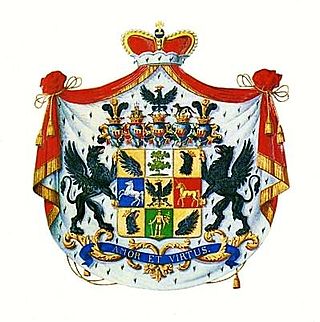
The House of Pückler, with branches named Pückler-Muskau, Pückler-Burghauss (Pückler-Burghauß), Pückler-Limpurg and Pückler-Groditz, was the name of an old and influential German noble family which originated from Silesia.
The German nobility and royalty were status groups of the medieval society in Central Europe, which enjoyed certain privileges relative to other people under the laws and customs in the German-speaking area, until the beginning of the 20th century. Historically, German entities that recognized or conferred nobility included the Holy Roman Empire (962–1806), the German Confederation (1814–1866) and the German Empire (1871–1918). Chancellor Otto von Bismarck in the German Empire had a policy of expanding his political base by ennobling nouveau riche industrialists and businessmen who had no noble ancestors. The nobility flourished during the dramatic industrialization and urbanization of Germany after 1850. Landowners modernized their estates, and oriented their business to an international market. Many younger sons were positioned in the rapidly growing national and regional civil service bureaucracies, as well as in the officer corps of the military. They acquired not only the technical skills but the necessary education in high prestige German universities that facilitated their success. Many became political leaders of new reform organizations such as agrarian leagues, and pressure groups. The Roman Catholic nobility played a major role in forming the new Centre Party in resistance to Bismarck's anti-Catholic Kulturkampf, while Protestant nobles were similarly active in the Conservative Party.

Christoph Beetz was ennobled by Emperor Charles VI in Vienna, Austria on 27 January 1734 as "Beez von Beezen" after receiving heritable membership of the old class of the Holy Roman Empire. His military career is highlighted by his command of a regiment at the age of 20 and his final appointment as Swedish Platz-Major and Stabs-Major of the military garrison in Stralsund. He was ranked with the same duties as a Stadt-General. His 1746 portrait still graces the interior of Saint Mary's Church, Stralsund, Germany where he is buried.
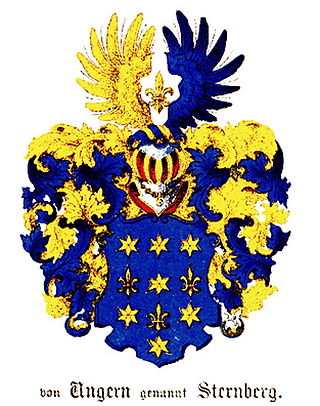
The Ungern-Sternberg family or von Ungern-Sternberg is an old and influential Baltic-German nobility, with branches belonging to the German, Finnish, Swedish and Russian nobility.

The Baltic German nobility was a privileged social class in the territories of modern-day Estonia and Latvia. It existed continuously from the Northern Crusades and the medieval foundation of Terra Mariana.

The von Rohr is an old German noble family, also belonging to the Swedish and Finnish nobility.
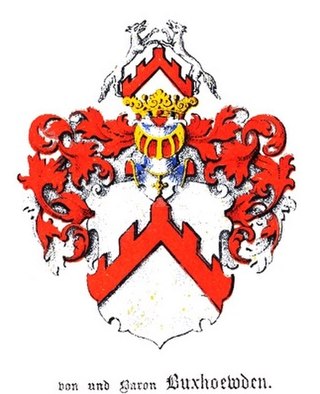
The Buxhoeveden family is a Baltic-German noble family of Lower Saxon origin in Estonia and Russian Empire, with roots tracing to Bexhövede, Bremen-Verden, Germany. In Sweden, the family is considered part of the unintroduced nobility. On 18 December 1795, members of the family were granted the title of Count in the Kingdom of Prussia, and on 16 April 1797 they were awarded with the same title in the Russian Empire.

The Manteuffel family is an old and influential German Pomeranian noble family, which later also resided in Brandenburg, Prussia, Silesia, Mecklenburg, Poland, the Baltics and in Russia.

Susan Christina von Saltza, also known by her married name Christina Olmstead, is an American former competition swimmer, Olympic champion, and former world record-holder in four events.

The Klinkowström family or Klinckowström is an old Prussian noble house whose members played prominent roles in the history of Prussia, Sweden and Austria.

Carl Frederick von Saltza was a Swedish-American artist and portrait painter. Saltza was best known in Sweden for his genre pictures in watercolor and for his drawings. He was one of the main illustrators for the 1893 edition of the Poetic Edda by Fredrik Sander (1828–1900). In the United States, Von Saltza was best known for his portraits.
A nobiliary particle is a type of onomastic particle used in a surname or family name in many Western cultures to signal the nobility of a family. The particle used varies depending on the country, language and period of time. In some languages, it is the same as a regular prepositional particle that was used in the creation of many surnames. In some countries, it became customary to distinguish the nobiliary particle from the regular one by a different spelling, although in other countries these conventions did not arise, occasionally resulting in ambiguity. The nobiliary particle can often be omitted in everyday speech or certain contexts.
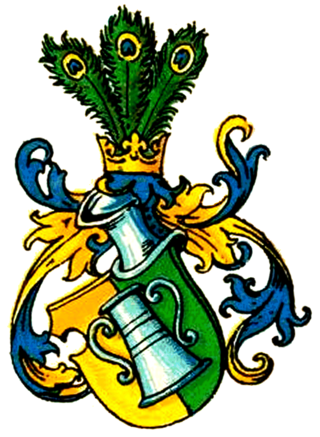
The Knorring family also spelled von Knorring is the name of an old Baltic-German noble family, whose members held significant positions within the Russian Empire and Scandinavia. They held the title of Baron in Sweden and Prussia.

Junker is a noble honorific, derived from Middle High German Juncherre, meaning 'young nobleman' or otherwise 'young lord'. The term is traditionally used throughout the German-speaking, Dutch-speaking and Scandinavian-speaking parts of Europe. It was also used in the Russian Empire due to Baltic German influence, up until the Russian Revolution. The term is currently still in use by the Georgian Defense Forces for student officers of the National Defence Academy.
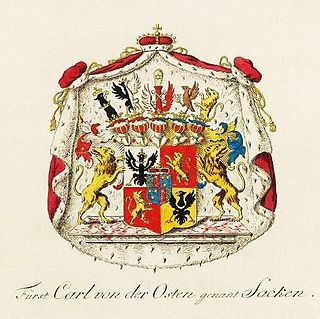
The House of Osten-Sacken is a noble family of Baltic Germans, which belonged to German, Swedish and Russian nobility. Members of the family held the titles of Baron, Graf, Knyaz and Fürst.

Philip Wenceslaus von Saltza was a Swedish-born American artist and muralist.


















